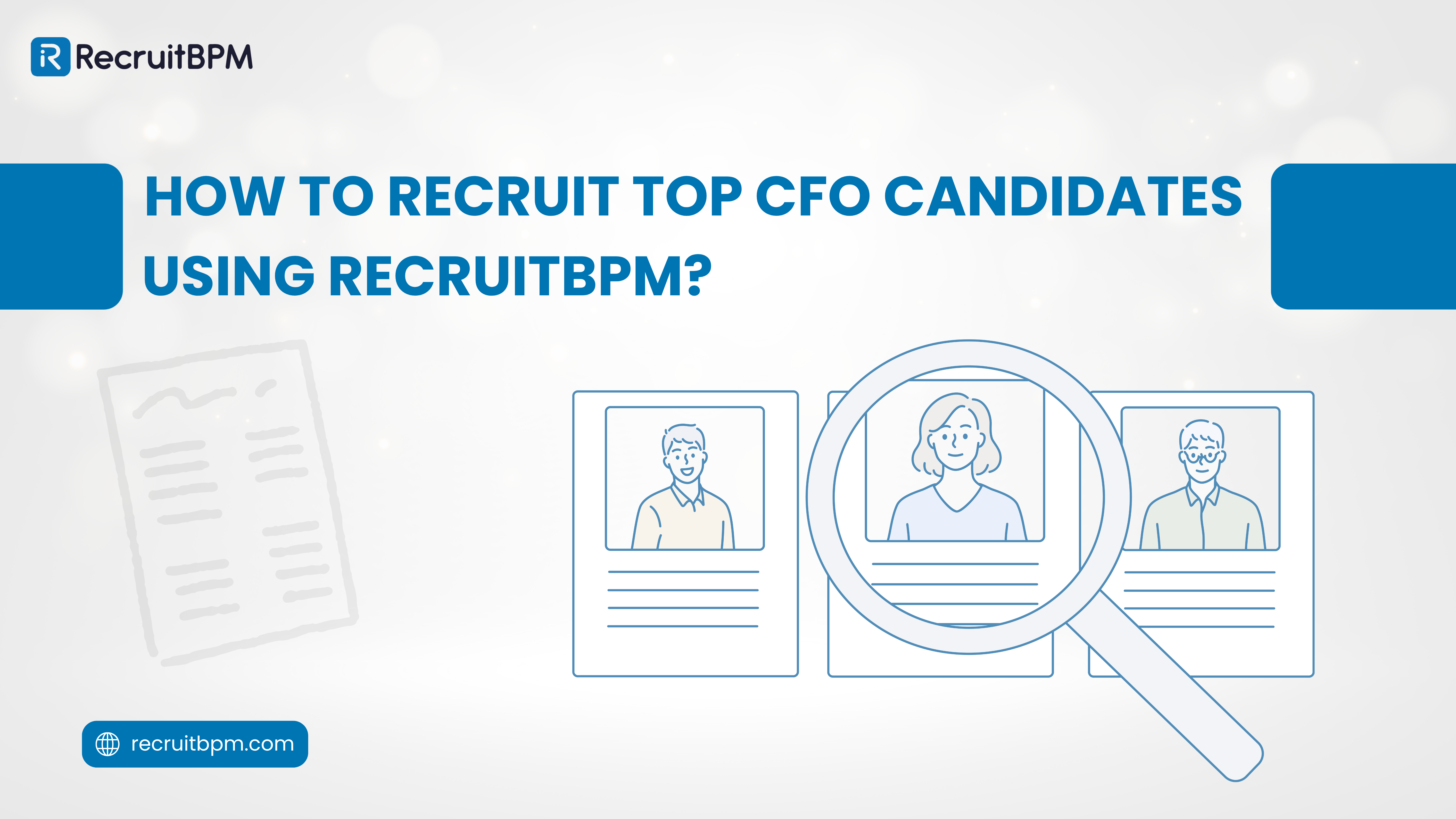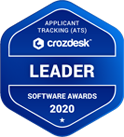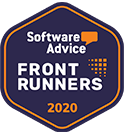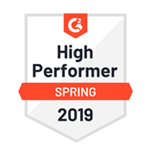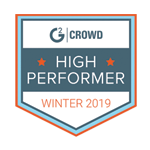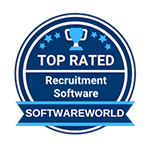Recruiting a Chief Financial Officer demands more than traditional hiring approaches. These executives shape financial strategy, drive growth, and influence every major business decision. For staffing agencies and recruitment firms, CFO placements represent high-value engagements that require specialized tools and systematic processes.
RecruitBPM transforms how agencies handle executive financial recruiting. This unified ATS and CRM platform streamlines complex CFO searches while maintaining the personal touch that executive candidates expect. Let’s explore how to leverage RecruitBPM’s capabilities for successful CFO recruitment.
Why CFO Recruitment Requires Specialized Tools?
Executive search differs fundamentally from standard recruiting. CFO candidates are passive, selective, and relationship-focused. They expect confidentiality, professionalism, and consultative engagement throughout the process.
Traditional spreadsheets and email chains fail when managing multiple stakeholder relationships. CFO searches involve boards, CEOs, private equity sponsors, and multiple internal decision-makers. Coordinating these relationships manually creates bottlenecks and risks losing top candidates.
The Complexity of Executive Financial Hiring
CFO searches typically span 90 to 180 days. During this period, recruiters must manage confidential communications, coordinate executive-level interviews, and maintain engagement with multiple candidates simultaneously.
Each search requires tracking detailed compensation structures. Base salaries for CFOs range from $150,000 in small companies to over $1 million in large corporations. Total compensation packages include bonuses averaging 50-59% of base salary, equity grants, and executive benefits.
Geographic variations add complexity. CFOs in San Francisco command 40% higher compensation than those in smaller markets. Industry specialization matters significantly, with technology and finance sectors offering premium compensation compared to non-profit organizations.
Common CFO Recruitment Challenges for Agencies
Staffing agencies face unique obstacles in executive financial recruiting. Limited visibility into passive candidate pools restricts sourcing options. Most qualified CFOs aren’t actively job hunting, making traditional job postings ineffective.
Maintaining confidentiality becomes paramount. Many CFO searches remain undisclosed until late stages. Recruiters must manage sensitive information while coordinating with multiple stakeholders who demand regular updates.
Client expectations escalate with executive roles. Organizations expect recruiters to present only purple squirrels—those perfect candidates with precisely the right combination of skills and experience. This requires sophisticated screening capabilities and detailed assessment frameworks that manual processes cannot support effectively.
Understanding the Modern CFO Role and Requirements
Today’s Chief Financial Officers serve as strategic partners rather than just financial gatekeepers. This evolution expands their responsibilities beyond traditional accounting and reporting into areas like digital transformation, risk management, and business development.
Organizations increasingly expect CFOs to drive value creation. They analyze data to identify growth opportunities. They advise on mergers and acquisitions. They communicate financial strategy to investors and boards.
Core Responsibilities of Today’s Chief Financial Officer
Financial planning and analysis form the foundation of CFO responsibilities. They develop budgets, create financial forecasts, and build models that guide strategic decisions. This work requires deep analytical skills and industry knowledge.
Capital management represents another critical function. CFOs secure funding through various sources, from traditional banking relationships to private equity partnerships. They determine optimal capital structures and manage relationships with investors and lenders.
Regulatory compliance and risk management demand constant attention. CFOs ensure financial reporting meets all regulatory requirements. They implement internal controls that prevent fraud. They develop risk mitigation strategies for operational, financial, and market risks.
Technology leadership has become essential. Modern CFOs champion digital transformation initiatives. They evaluate and implement financial technology solutions. Many now oversee IT departments as finance and technology converge.
When Organizations Need a CFO
Early-stage companies often delay CFO hiring until reaching $35-50 million in annual revenue. Before this threshold, a controller or fractional CFO typically suffices. Growth beyond this point creates complexity that demands full-time financial leadership.
Major transitions trigger CFO searches. Companies preparing for initial public offerings need experienced CFOs who understand regulatory requirements. Organizations pursuing acquisitions require deal-making expertise. Businesses entering new markets benefit from CFOs with relevant geographic or industry experience.
Financial distress situations demand immediate CFO intervention. Turnaround specialists bring expertise in restructuring, creditor negotiations, and operational improvements. These interim placements often transition to permanent roles once stability returns.
Types of CFO Candidates to Target
Operator CFOs excel at building financial infrastructure and managing daily operations. These candidates typically advance through controller or VP Finance roles. They understand accounting systems, internal controls, and process optimization.
Their hands-on approach benefits growing companies that need to build scalable financial operations. However, organizations may need to pair them with strong accounting talent for technical expertise.
CPA CFOs bring technical accounting expertise and deep knowledge of regulatory compliance. These candidates typically start in public accounting before transitioning to industry roles. They excel at financial reporting, audit management, and technical accounting matters.
Organizations in highly regulated industries particularly value CPA backgrounds. However, these candidates may need supplementary support for strategic planning and financial modeling capabilities.
Deal-maker CFOs specialize in capital raising and mergers and acquisitions. Their backgrounds typically include investment banking or private equity experience. They maintain extensive networks in financial services and excel at structuring complex transactions.
Companies in growth mode or pursuing acquisitions benefit from this profile. These candidates may require support from strong accounting teams for operational financial management.
Traditionalist CFOs represent the most complete package. They combine FP&A experience with operational management skills. Their diverse backgrounds typically include several years across different financial functions.
These well-rounded candidates adapt to various organizational needs. They command premium compensation due to their versatility and proven track records.
Setting Up RecruitBPM for CFO Recruitment Success
Strategic platform configuration accelerates CFO search effectiveness. Proper setup ensures your team can manage complex executive searches without manual workarounds. This foundation supports consistent processes across all CFO engagements.
RecruitBPM’s customization capabilities allow you to tailor the system specifically for executive financial recruiting. These configurations save hours on every search while improving candidate and client experiences.
Configuring Your ATS for Executive Search
Custom candidate fields capture CFO-specific qualifications. Create fields for technical certifications like CPA or CFA. Add fields for M&A transaction experience, capital raising history, and industry specialization. Include fields for preferred company size and compensation expectations.
Tag systems enable sophisticated candidate segmentation. Tag candidates by CFO type: Operator, CPA, Deal-Maker, or Traditionalist. Use tags for industry expertise like Technology, Healthcare, Manufacturing, or Finance. Geographic preference tags help identify candidates open to relocation.
Pipeline stages should reflect executive search realities. Standard stages like “Sourced,” “Initial Contact,” “Preliminary Screen,” “Client Presentation,” “First Interview,” and “Final Interview” work well. Add executive-specific stages like “Reference Check” and “Offer Negotiation.”
Custom workflows automate stage transitions. When candidates move to “Client Presentation,” automatically trigger notifications to account managers. Schedule reminder tasks for follow-ups after executive interviews. These automations prevent qualified candidates from languishing in your pipeline.
Customizing CRM Fields for CFO Client Management
Client records need specialized fields for CFO searches. Capture reporting structure details: does the CFO report to the CEO, board, or private equity sponsor? Document decision-maker involvement throughout the search process.
Compensation framework fields prove essential. Record approved salary ranges, bonus structures, equity allocation, and non-cash benefits. Track competing offers and compensation benchmarks for the client’s industry and size.
Search specifications require detailed documentation. Capture required versus preferred qualifications. Note cultural fit priorities and leadership style preferences. Document any dealbreakers or red flags identified during intake discussions.
Stakeholder management features organize complex approval processes. Link multiple contacts to each client organization. Tag their roles: CEO, Board Chair, HR Director, or CFO Selection Committee member. Track each stakeholder’s priorities and concerns throughout the search.
Building CFO-Specific Job Templates in RecruitBPM
Well-crafted templates accelerate job posting while ensuring consistency. Start with comprehensive CFO job description templates that cover common responsibilities. Customize them for different CFO types and company sizes.
Include industry-specific language that attracts qualified candidates. Technology company CFO postings should emphasize software capitalization, revenue recognition for SaaS models, and venture capital relationships. Healthcare CFO postings should highlight regulatory compliance, reimbursement models, and system integrations.
Compensation disclosure strategies require careful consideration. Some postings benefit from transparent salary ranges that filter unqualified candidates early. Others maintain confidentiality until later stages. Build templates for both approaches.
Sourcing channel selection varies by candidate type. LinkedIn job postings reach active candidates but miss passive executives. Your templates should include posting configurations for multiple channels: LinkedIn, executive job boards, and your company career portal.
Sourcing Top CFO Candidates with RecruitBPM
Effective sourcing combines multiple strategies. Relying solely on job postings yields insufficient candidate flow for executive roles. RecruitBPM’s integrated sourcing tools enable multi-channel approaches that build robust CFO pipelines.
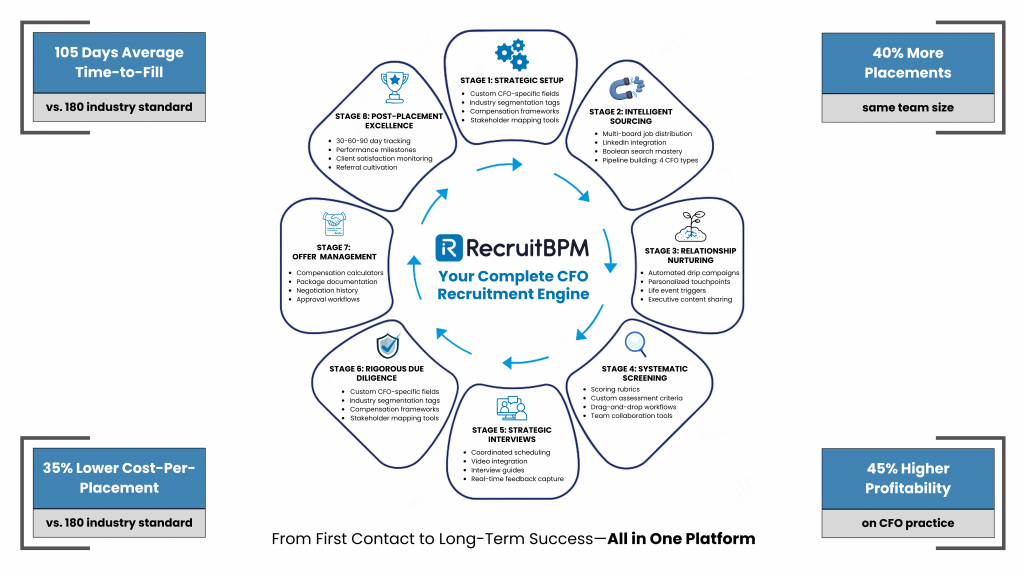
The platform’s automation capabilities let you maintain consistent sourcing activity. Regular outreach to passive candidates creates relationships before needs arise. This proactive approach positions your agency as a trusted advisor rather than a transactional vendor.
Leveraging Multi-Board Job Posting for Executive Roles
RecruitBPM’s one-click job distribution reaches multiple platforms simultaneously. Post CFO opportunities to LinkedIn, Indeed, Monster, and executive-focused boards through a single interface. This broad reach increases visibility among active candidates.
Executive job boards deserve particular attention. Sites like ExecThread, BlueSteps, and TheBoard attract senior financial leaders. RecruitBPM’s integrations enable posting to these premium channels without manual data entry.
Social media amplification extends job posting reach. RecruitBPM automatically shares postings to company social channels. LinkedIn particularly drives engagement for executive roles. Twitter and Facebook provide additional touchpoints with passive candidates.
Posting analytics reveal which channels produce results. Track application sources for every CFO candidate. Calculate cost-per-applicant across different boards. Reallocate budget toward the highest-performing channels over time.
Using Advanced Resume Search for CFO Qualifications
Boolean search capabilities identify candidates with specific qualifications. Search for “CFO OR ‘Chief Financial Officer’ OR ‘VP Finance'” combined with required skills. Add industry terms, certifications, or company size criteria to refine results.
Resume parsing extracts key information automatically. The system identifies candidates with relevant titles, required certifications, and appropriate tenure. This automation reduces manual screening time significantly.
Keyword matching scores candidates based on job requirements. RecruitBPM analyzes how closely candidate profiles align with CFO specifications. High-scoring candidates receive priority review, ensuring your team focuses on the most qualified prospects.
Saved searches enable ongoing candidate identification. Configure searches for different CFO types. Schedule them to run automatically, delivering new candidates to your inbox weekly. This consistent sourcing activity builds pipeline depth over time.
Building Your CFO Talent Pipeline with CRM
Relationship management drives executive recruiting success. RecruitBPM’s CRM capabilities let you nurture passive candidates over extended periods. This long-term approach yields higher-quality placements than transactional recruiting.
Segment your CFO database by readiness to move. Tag candidates as “Actively Looking,” “Open to Opportunities,” or “Happy but Interested.” Tailor outreach frequency and messaging to each segment.
Touch-point tracking maintains relationship continuity. Log every interaction: calls, emails, coffee meetings, and conference encounters. Notes capture career aspirations, timing considerations, and compensation expectations. This documented history enables seamless handoffs between team members.
Life event triggers identify outreach opportunities. When candidates update LinkedIn profiles with new roles, RecruitBPM can flag these changes. Congratulatory messages maintain relationships. After appropriate tenure, check in about future opportunities.
Social Recruiting Strategies for Financial Executives
LinkedIn integration streamlines professional networking. RecruitBPM’s Chrome extension captures candidate information directly from LinkedIn profiles. One click adds prospects to your database with complete profile data.
Content marketing attracts passive candidates. Share thought leadership about CFO career paths, compensation trends, and industry insights. RecruitBPM schedules social posts across platforms. Engaged followers self-identify as potential candidates.
Employee advocacy amplifies reach. Your recruiters’ personal networks provide access to executive circles. RecruitBPM enables easy sharing of opportunities. Team members become brand ambassadors within their professional communities.
Alumni networks offer rich sourcing pools. Connect with CFOs from target companies, business schools, and accounting firms. RecruitBPM’s tagging system helps organize these network segments. Targeted campaigns leverage these shared backgrounds.
Managing CFO Client Relationships in RecruitBPM
Client management complexity increases dramatically with executive searches. Multiple stakeholders demand regular updates. Changing requirements need quick incorporation. Confidentiality concerns require careful information management.
RecruitBPM’s integrated CRM ensures consistent client experiences. All team members have access to the complete engagement history. Communication logs prevent duplicate outreach. Stakeholder preferences guide interaction approaches.
Tracking CFO Search Requirements and Specifications
Intake conversations establish search foundations. Document required qualifications: education, certifications, years of experience, and industry background. Capture preferred but not required attributes. Note any absolute dealbreakers.
Success profiles go beyond qualifications. Understand the business context driving the search. Is the company preparing for an IPO? Pursuing acquisitions? Navigating financial challenges? These situations demand specific CFO profiles.
Cultural fit criteria often determine final selection. Some organizations value conservative, risk-averse approaches. Others seek entrepreneurial, aggressive leaders. Document cultural attributes and leadership style preferences.
Search specification changes happen frequently. Clients refine requirements as they meet candidates. RecruitBPM’s version history tracks specification evolution. This documentation prevents confusion about current requirements.
Using Contact Management for Executive Decision-Makers
Stakeholder mapping identifies all decision participants. CFO searches typically involve CEOs, board members, private equity sponsors, and other executives. Document each stakeholder’s role, priorities, and influence level.
Communication preferences vary across stakeholders. Some prefer email updates. Others want phone calls. Board members may limit availability to specific times. RecruitBPM’s contact records store these preferences.
Permission levels ensure appropriate information sharing. Compensation details might share with CEOs but not search committee members. Candidate names remain confidential until later stages. Field-level permissions control information access.
Meeting scheduling across multiple executives challenges recruiters. RecruitBPM’s calendar integration reveals stakeholder availability. Group scheduling tools coordinate panel interviews. Automated confirmations reduce no-shows.
Email Integration for Professional CFO Communications
Two-way email sync maintains complete communication records. Every client email automatically logs in to RecruitBPM. Team members see the full conversation history without forwarding chains. This visibility ensures consistent messaging.
Template libraries standardize professional communications. Create templates for search updates, candidate presentations, and interview scheduling. Personalization fields automatically insert relevant details. This consistency maintains brand professionalism.
Email tracking provides engagement insights. Know when clients open candidate profiles. See which attached materials generate interest. Follow up strategically based on engagement data.
Bulk communication capabilities enable efficient updates. Send weekly search progress reports to all stakeholders simultaneously. Personalize each message while leveraging template efficiency. This balance maintains relationships without excessive time investment.
Calendar Scheduling for High-Level CFO Interviews
Executive interview coordination demands precision. Busy schedules require flexibility and quick turnaround. RecruitBPM’s scheduling features streamline this complex coordination.
Availability sharing eliminates phone tag. Send scheduling links to candidates and clients. They select times from your available slots. Confirmations generate automatically once times are selected.
Buffer time between interviews prevents schedule overruns. Configure minimum gaps between appointments. This cushion accommodates conversations that run long. It also provides preparation time for subsequent interviews.
Interview preparation reminders ensure readiness. Automated emails send candidate profiles to interviewers beforehand. Reminders include interview questions and evaluation criteria. These materials enable structured, consistent assessments.
Screening and Evaluating CFO Candidates
Rigorous screening separates exceptional executives from merely qualified candidates. CFO hiring mistakes carry enormous costs. Bad hires damage organizational performance, delay strategic initiatives, and require expensive replacement searches.
RecruitBPM’s screening tools enable systematic, objective evaluations. Consistent frameworks reduce bias while identifying candidates who truly fit client needs.
Essential Qualities in Top CFO Candidates
Financial expertise forms the foundation of CFO capability. Look for a deep understanding of financial planning, analysis, and reporting. Evaluate experience with relevant accounting standards and regulatory requirements. Assess modeling skills and analytical capabilities.
Strategic thinking separates great CFOs from good ones. Top candidates articulate clear financial strategies aligned with business objectives. They identify opportunities and risks before others notice them. They translate financial data into actionable insights.
Leadership abilities prove essential for CFO success. These executives often oversee large finance teams. They influence organizational culture through their approaches. Look for evidence of developing talent, building high-performing teams, and driving change initiatives.
Communication skills enable CFO effectiveness. These leaders must explain complex financial matters to non-financial audiences. They present to boards, negotiate with bankers, and represent organizations externally. Assess both written and verbal communication capabilities.
Adaptability matters increasingly in dynamic environments. CFOs navigate market volatility, regulatory changes, and organizational transitions. Evaluate how candidates have handled unexpected challenges. Look for learning agility and willingness to embrace new approaches.
Integrity represents a non-negotiable quality. CFOs access sensitive information and make decisions with significant ethical dimensions. Check references carefully. Look for any history of questionable judgment or ethical lapses.
Creating CFO Assessment Criteria in RecruitBPM
Scoring rubrics enable objective candidate comparisons. Define specific criteria for evaluating each quality. Assign point values to different proficiency levels. Total scores help identify top candidates while highlighting specific strengths and weaknesses.
Custom fields capture evaluation data systematically. Create fields for technical skills assessment, strategic thinking evaluation, leadership capability scores, and cultural fit ratings. Require completion of these fields before candidates advance.
Evaluation forms standardize assessments across team members. Build forms that guide evaluators through structured questions. Include rating scales for consistent scoring. Add comment fields for qualitative observations.
Comparative analysis reveals relative candidate strengths. RecruitBPM’s reporting can compare candidates side-by-side across evaluation criteria. Visual dashboards highlight top performers. This data-driven approach supports confident client presentations.
Organizing Candidate Pipelines by CFO Specialization
Segmented pipelines improve candidate management. Create separate pipelines for different CFO types: Operators, CPAs, Deal-Makers, and Traditionalists. This organization enables targeted communication and appropriate opportunity matching.
Industry-specific pipelines help match candidates to clients. Separate pipelines for Technology, Healthcare, Manufacturing, and Finance CFOs ensure relevant candidate presentations. Industry expertise increasingly influences hiring decisions.
Geographic pipelines accommodate location preferences. Some candidates require specific regions. Others are fully mobile. Organized pipelines enable quick identification of candidates open to particular locations.
Pipeline health metrics guide sourcing priorities. Monitor candidate volume at each stage. Identify bottlenecks where candidates stall. Adjust sourcing activities to maintain a healthy pipeline flow across all segments.
Drag-and-Drop Management for Executive Workflows
Visual pipeline management simplifies candidate tracking. Drag candidates between stages as they progress. This intuitive interface requires no training. It provides instant visibility into search status.
Batch operations enable efficient pipeline management. Move multiple candidates simultaneously when appropriate. Update candidate statuses in bulk after client feedback sessions. These efficiencies matter when managing multiple simultaneous searches.
Automated stage transitions reduce manual work. When candidates complete phone screens, automatically move them to “Client Presentation.” When offers are extended, transition to “Offer Negotiation.” These automations ensure pipelines reflect the current reality.
Custom views focus attention appropriately. Create views showing candidates pending action. Filter for candidates requiring follow-up. Display only candidates at specific stages. These focused views help recruiters prioritize daily activities.
Conducting Strategic CFO Interview Processes
Interview quality directly impacts placement success. Superficial conversations miss critical red flags. Poorly structured interviews fail to assess key competencies. Strategic interview approaches reveal candidate capabilities while showcasing your agency’s professionalism.
RecruitBPM facilitates structured, effective interview processes. Documentation features ensure insights don’t get lost. Collaboration tools enable team-based evaluations.
Interview Questions for Financial Strategy Assessment
Scenario-based questions reveal strategic thinking. Ask candidates how they would approach specific financial challenges: “Our client is considering international expansion. Walk me through your financial analysis framework.” Their responses demonstrate analytical processes and strategic considerations.
Historical performance questions provide concrete examples. “Describe your most successful strategic financial initiative. What was the situation, your approach, and the results?” Look for clear articulation of challenges faced, decisions made, and measurable outcomes achieved.
Future-focused questions assess adaptability. “How are you preparing for emerging trends in financial technology?” or “What skills will CFOs need in five years?” Answers reveal a continuous learning mindset and a forward-thinking orientation.
Technical depth questions verify expertise. Discuss specific accounting standards, complex financial instruments, or regulatory requirements relevant to the opportunity. Qualified candidates explain technical matters clearly and accurately.
Leadership and Communication Evaluation Questions
Team development questions reveal leadership philosophy. “How do you build high-performing finance teams?” or “Tell me about a time you developed someone into a leadership role.” Strong answers demonstrate commitment to talent development.
Change management questions assess leadership capability. CFOs often drive significant organizational changes. Ask about times they led difficult transitions. Evaluate their approaches to resistance, communication, and stakeholder management.
Conflict resolution questions provide insights into emotional intelligence. “Describe a significant disagreement with a CEO or board member. How did you handle it?” Look for professional approaches that maintain relationships while advocating for correct financial decisions.
Communication style assessment happens throughout conversations. Note how clearly candidates explain complex topics. Observe their active listening. Assess their ability to tailor communication to different audiences.
Using RecruitBPM for Interview Coordination
Interview scheduling features streamline coordination. Send calendar links to candidates for self-scheduling. Automated confirmations reduce no-shows. Reminder emails keep interviews top-of-mind for busy executives.
Video interview integration enables efficient screening. Conduct preliminary interviews through RecruitBPM’s video features. Record sessions for team review. This flexibility accommodates candidates across different time zones.
Interview guide storage ensures consistency. Upload structured interview questions to candidate records. All team members use the same frameworks. This consistency enables objective comparisons across candidates.
Post-interview documentation captures fresh insights. Immediately after interviews, log observations while details remain clear. Rate candidates across key competencies. These contemporaneous notes prove invaluable during final selection discussions.
Collaborative Team Feedback in the Platform
Shared candidate access enables team collaboration. Multiple recruiters and account managers view the same records. Everyone sees the complete candidate history. This transparency prevents duplicate efforts and ensures consistent messaging.
Comment threads facilitate asynchronous discussions. Team members share observations without scheduling meetings. Questions get answered in context. Decisions get documented for future reference.
Evaluation aggregation reveals team consensus. When multiple team members interview candidates, RecruitBPM can aggregate their scores. Identify candidates with consistently high ratings. Flag significant rating discrepancies for discussion.
Client collaboration features extend beyond internal teams. Share candidate profiles with clients through secure portals. Clients add comments and ratings. This transparency builds trust while gathering valuable feedback efficiently.
Leveraging RecruitBPM Automation for CFO Recruitment
Automation eliminates repetitive tasks without sacrificing personalization. Executive candidates expect responsive, professional communication. Automation ensures consistent engagement while freeing recruiters for high-value activities.
RecruitBPM’s automation capabilities extend across the entire recruitment lifecycle. Strategic automation accelerates placements while improving candidate and client experiences.
Email Sequences for Executive Candidate Nurturing
Drip campaigns maintain engagement with passive candidates. Create sequences that provide value over time: industry insights, market trends, career development resources. Space touchpoints appropriately for executive audiences.
Personalization tokens customize automated messages. Insert candidate names, companies, and relevant details automatically. Reference specific skills or experiences mentioned in profiles. This personalization maintains human connection despite automation.
Behavior-triggered emails respond to candidate actions. When candidates open emails, trigger follow-up messages. When they view job postings, send additional details. These timely responses capitalize on demonstrated interest.
A/B testing optimizes message effectiveness. Test different subject lines, messaging approaches, and calls-to-action. Measure open rates, response rates, and conversion rates. Continuously refine sequences based on performance data.
Automated Follow-Ups for CFO Search Updates
Client update automation maintains consistent communication. Schedule weekly progress reports that generate automatically. Include metrics like candidates sourced, screens completed, and interviews scheduled. This regular communication builds client confidence.
Candidate status updates keep prospects engaged. When pipeline stages change, trigger appropriate messages. Moving to “Client Presentation” triggers messages about next steps. “Interview Scheduled” stages send preparation materials automatically.
Reminder automation ensures timely actions. Schedule follow-up tasks automatically after key events. Three days after an interview, remind recruiters to gather feedback. One week after candidate presentations, prompt clients for decisions.
Abandoned candidate re-engagement campaigns revive stalled opportunities. When candidates stop responding, automated sequences attempt re-engagement. Sometimes, timing was simply wrong. These campaigns capture candidates when circumstances change.
Workflow Automation for Placement Tracking
Placement milestones trigger automated processes. When offers are accepted, initiate onboarding sequences. Generate required paperwork. Schedule start date planning meetings. These workflows ensure smooth transitions.
Background check automation accelerates the final stages. When candidates reach the “Final Stage,” they automatically request background checks. Integrate with screening vendors for seamless processing. Receive results directly in candidate records.
Reference check workflows standardize this critical process. Generate reference request templates automatically. Track response status. Compile feedback systematically. This structure ensures thorough due diligence.
Post-placement follow-up maintains relationships. Schedule automated check-ins at 30, 60, and 90 days. These touchpoints identify issues early. They also demonstrate ongoing partnership commitment.
Time-Saving Features for High-Touch Recruiting
Template libraries accelerate routine communications. Build templates for common scenarios: candidate outreach, client updates, interview scheduling, and offer communications. Customize quickly rather than drafting from scratch.
Bulk actions enable efficient database management. Update multiple candidate statuses simultaneously. Send batch emails to targeted segments. Tag groups of candidates based on shared characteristics.
Mobile access supports recruiting on the go. Access candidate records from smartphones. Send quick updates between meetings. This flexibility prevents delays when away from desks.
Chrome extension capabilities streamline sourcing. Capture LinkedIn profiles directly into RecruitBPM with one click. Add notes about potential candidates immediately. This seamless integration makes consistent sourcing activity realistic.
Reference Checks and Due Diligence for CFO Hires
Reference checking represents a critical protection against bad hires. CFO mistakes create enormous organizational damage. Thorough reference checks reveal red flags that interviews might miss.
RecruitBPM’s documentation capabilities ensure systematic, comprehensive reference processes. Structured approaches yield more valuable insights than ad-hoc conversations.
Red Flags to Watch in CFO Candidates
Integrity concerns represent absolute disqualifiers. Any history of financial impropriety, even if technically legal, raises serious questions. Evasiveness about past decisions suggests potential ethical issues.
Questionable judgment patterns require careful evaluation. Review past decisions that led to negative outcomes. Were they reasonable given the available information? Or do they reveal consistent poor judgment?
Frequent job changes may indicate performance issues. While some movement is natural, excessive turnover suggests potential problems. Investigate reasons for each departure. Look for patterns of conflict or unrealistic expectations.
Communication skill deficits limit CFO effectiveness. Inability to explain financial concepts clearly creates organizational problems. Poor listening skills damage relationships. Assess these capabilities throughout interactions.
Resistance to feedback suggests inflexibility. CFOs must adapt to changing circumstances and incorporate diverse perspectives. Candidates who defend every past decision without acknowledging lessons learned may struggle with growth.
Technical skill gaps in core areas create immediate problems. CFOs must understand fundamental accounting principles, financial analysis, and regulatory requirements. Deficiencies in these areas undermine credibility and effectiveness.
Managing Background Verification in RecruitBPM
Background check workflow configuration streamlines verification processes. Define which checks are required: criminal history, credit reports, education verification, employment verification, and professional licenses.
Vendor integration enables seamless processing. Connect RecruitBPM with background screening providers. Order checks directly from candidate records. Receive results automatically into the platform.
Compliance documentation protects your agency. Store candidate authorizations for background checks. Document compliance with Fair Credit Reporting Act requirements. This systematic approach reduces legal risk.
Results tracking maintains visibility. Monitor background check status for all candidates. Flag any concerning findings immediately. Ensure necessary verifications are complete before offers are finalized.
Documenting Reference Check Results
Reference check templates ensure comprehensive coverage. Build question sets that address key competencies: financial expertise, strategic thinking, leadership capability, communication skills, and integrity. Include questions about performance under pressure and relationships with stakeholders.
Note-taking systems capture valuable details. Document specific examples provided by references. Record exact quotes when particularly relevant. These detailed notes support decision-making discussions.
Pattern identification across multiple references reveals the truth. Single negative comments might reflect personality conflicts. Consistent feedback across references indicates real patterns. Look for themes emerging across multiple conversations.
Red flag escalation processes ensure appropriate visibility. When references reveal concerning information, immediately notify relevant team members. Document conversations thoroughly. Discuss implications before proceeding with candidates.
Ensuring Compliance in Executive Placements
Employment eligibility verification prevents placement complications. Confirm work authorization for all candidates. This basic step prevents embarrassing situations after offers are accepted.
Professional license verification confirms claimed credentials. Validate CPA licenses, state registrations, and other professional certifications. Some credentials require active status maintenance.
Education verification confirms academic claims. Degree mills and credential inflation create risks. Verify degrees from claimed institutions. Confirm graduation dates and fields of study.
Conflict of interest screening protects clients. Identify any potential conflicts between candidates and client organizations. Financial relationships, competitive employment, or other conflicts require careful evaluation and disclosure.
Analytics and Reporting for CFO Recruitment Success
Data-driven recruiting improves outcomes while demonstrating value to clients. RecruitBPM’s analytics capabilities provide insights that manual tracking cannot capture.
Metrics guide process improvements. They also showcase your agency’s effectiveness when presenting capabilities to prospective clients.
Tracking Time-to-Fill for Executive Positions
Pipeline velocity metrics reveal efficiency. Calculate the average days at each stage. Identify where candidates move quickly versus where they stall. Focus improvement efforts on bottleneck stages.
Source-to-hire tracking shows which channels work. Measure time from initial candidate identification to placement for each sourcing method. Referrals might convert faster than job board responses despite lower volume.
Comparative analysis across searches reveals patterns. Some clients decide quickly. Others require extended evaluation periods. Understanding these patterns helps set realistic expectations for new searches.
Historical trending shows performance improvement over time. Track time-to-fill across quarters and years. Demonstrate continuous improvement to clients. Identify factors contributing to efficiency gains.
Monitoring CFO Placement Success Rates
Conversion rates at each stage diagnose process health. What percentage of sourced candidates advance to screens? How many screened candidates reach client presentations? These metrics reveal where you’re losing candidates.
Offer acceptance rates indicate competitive positioning. High decline rates suggest compensation misalignment or ineffective selling. Adjust strategies based on the declination reasons.
Placement retention tracking demonstrates long-term success. Monitor whether placed CFOs remain in roles after 90 days, six months, and one year. High retention validates your screening effectiveness.
Client satisfaction metrics prove value delivery. Survey clients about their experiences. Measure satisfaction with candidates presented, process speed, and communication quality. These insights guide service improvements.
Using KPI Dashboards for Team Performance
Individual performance metrics drive accountability. Track placements per recruiter, sourcing activity levels, and client satisfaction scores. Recognize top performers. Coach those needing improvement.
Team productivity dashboards provide management visibility. Monitor overall pipeline health across all searches. Identify team members who might need additional support. Celebrate team successes visibly.
Real-time activity monitoring ensures consistent effort. See daily sourcing activity, candidate outreach, and client communications. Address inactivity promptly. Reinforce productive behaviors.
Goal tracking maintains focus on objectives. Set monthly and quarterly targets for placements, sourcing activity, and client acquisition. Display progress toward goals prominently. This visibility motivates consistent performance.
ROI Analysis for CFO Search Engagements
Revenue per placement calculations demonstrate profitability. Track fees earned versus time invested. Identify your most profitable client relationships. Understand which search types yield the best returns.
Cost analysis reveals efficiency opportunities. Calculate expenses for different sourcing channels. Evaluate technology investments based on time savings. Make data-driven budget allocation decisions.
Client lifetime value guides relationship investments. Calculate total revenue from each client relationship over time. Identify your most valuable clients. Invest appropriately in maintaining these partnerships.
Market positioning insights inform pricing strategies. Compare your fees, time-to-fill, and success rates against market benchmarks. Identify competitive advantages. Justify premium pricing with superior performance metrics.
Managing CFO Compensation and Offers
Compensation negotiations make or break CFO placements. These executives have a sophisticated understanding of their market value. They expect professional, transparent discussions about total compensation.
RecruitBPM’s documentation capabilities ensure all parties maintain clarity throughout negotiation processes. Detailed records prevent misunderstandings that derail placements.
Current CFO Salary Benchmarks and Ranges
Small company CFOs earn $150,000 to $250,000 annually in base salary. Organizations with revenues under $50 million typically fall into this range. Geographic location and industry significantly influence specific amounts.
Mid-market CFO compensation ranges from $250,000 to $400,000 in base salary. Companies with $50 million to $1 billion in revenue typically offer this range. These roles often include substantial bonus potential.
Large company CFOs command $400,000 to over $1 million in base compensation. Organizations exceeding $1 billion in revenue compete at these levels. Public companies and private equity-backed firms typically offer the highest packages.
Geographic variations significantly impact compensation. CFOs in San Francisco, New York, and Boston earn 30-40% more than those in smaller markets. Cost of living differences explain only part of this gap.
Structuring Executive Compensation Packages
Base salary forms the foundation but represents only part of total compensation. For CFOs, base typically represents 40-50% of total target compensation. The remainder comes from variable components.
Annual incentive bonuses average 50-59% of base salary for middle-market and large company CFOs. Smaller companies typically offer lower percentages. These bonuses tie to financial performance metrics and strategic objectives.
Long-term incentives align the CFO’s interests with organizational success. Stock options, restricted stock units, and performance shares typically vest over three to four years. These components often exceed the annual base salary value.
Benefits packages include standard elements plus executive perks. Health insurance, retirement plans, and life insurance form the baseline. Executive benefits might include car allowances, club memberships, financial planning services, and enhanced vacation policies.
Signing bonuses sometimes sweeten offers for highly sought-after candidates. These one-time payments help candidates leave current positions. They offset forfeited bonuses or unvested equity from previous employers.
Severance protection provides downside security. Golden parachute provisions protect CFOs if organizational changes occur. These might include guaranteed severance multiples or accelerated equity vesting upon termination without cause.
Documenting Offer Details in RecruitBPM
Offer letter templates ensure completeness and consistency. Build templates that include all compensation components. Add fields for base salary, target bonus percentage, equity grants, and benefits. Include start date, reporting relationships, and key responsibilities.
Compensation package calculators help candidates understand total value. Build tools that show total compensation across multiple years. Factor in equity vesting schedules and projected bonus payments. These visualizations help candidates appreciate the full package value.
Negotiation history tracking maintains clarity. Document each offer iteration with dates and specific changes. Record candidate responses and specific objections or requests. This detailed history prevents confusion during extended negotiations.
Approval workflows route offers appropriately. Configure RecruitBPM to require an account manager review before sending offers. Add client approval steps for unusual terms. These controls prevent unauthorized commitments.
Onboarding and Placement Management
Successful placements require more than signed offer letters. The first 90 days determine long-term success. Strategic onboarding prevents early departures while positioning CFOs for impact.
RecruitBPM’s post-placement features help agencies maintain engagement through critical transition periods. This continued involvement strengthens client relationships while protecting placement fees.
CFO Onboarding Best Practices
Pre-start preparation sets the stage for success. Schedule meetings between new CFOs and key stakeholders before day one. Provide organizational charts, financial statements, and strategic plans for review. These materials enable productive first weeks.
First week activities should balance learning and relationship building. New CFOs need to understand current financial operations, systems, and processes. They also must establish credibility with finance teams and build relationships with executive peers.
30-day priorities focus on assessment. CFOs should evaluate financial infrastructure, team capabilities, and reporting processes. They identify immediate improvements while developing longer-term strategies. Regular check-ins with CEOs ensure alignment.
60-day milestones demonstrate progress. CFOs should implement some quick wins while advancing strategic initiatives. They present preliminary findings to boards. They establish their leadership within finance departments.
90-day reviews assess overall effectiveness. Has the CFO established credibility? Are key relationships functioning well? Have early initiatives shown results? These assessments identify any concerns requiring attention.
Using Back Office Features for Placement Tracking
Placement records centralize all post-hire information. Document start dates, compensation details, and key terms. Store signed agreements. Maintain complete histories accessible to authorized team members.
Performance milestone tracking monitors early success indicators. Create tasks for 30, 60, and 90-day check-ins. Set reminders for guarantee period endings. These systematic touchpoints identify issues early when interventions remain possible.
Issue escalation workflows ensure appropriate responses. When check-ins reveal concerns, trigger notification processes. Involve senior agency leadership when necessary. Document all intervention attempts thoroughly.
Client satisfaction monitoring maintains relationship health. Schedule regular conversations with hiring managers separate from candidate check-ins. These discussions assess whether CFOs are meeting expectations. They also identify additional opportunities to provide value.
Time and Expense Management for Interim CFOs
Timesheet systems track interim CFO hours accurately. RecruitBPM’s time management features let interim executives submit hours worked. Supervisors approve submissions. This systematic tracking prevents billing disputes.
Expense reporting streamlines reimbursement processes. Interim CFOs submit expenses through the RecruitBPM portals. Attach receipt images directly to submissions. Route for appropriate approvals before processing reimbursements.
Invoicing automation accelerates payment cycles. Generate invoices automatically based on approved time and expenses. Send to clients electronically. Track payment status within the platform.
Revenue recognition for interim placements requires careful tracking. Document hourly rates, total hours worked, and amounts billed. This detailed tracking supports accurate financial reporting for your agency.
Ensuring Long-Term CFO Placement Success
Relationship maintenance prevents placement failures. Stay connected with both clients and placed CFOs. Offer to facilitate difficult conversations if issues arise. Position your agency as a resource beyond the initial placement.
Skill development support adds ongoing value. Share professional development opportunities relevant to placed CFOs. Invite them to industry events. This continued engagement strengthens relationships.
Market intelligence gathering from placed CFOs benefits your practice. They provide insights about compensation trends, common challenges, and emerging needs. These conversations inform your broader CFO recruiting strategies.
Referral cultivation turns successful placements into new business. Satisfied CFOs recommend your services to peers. They alert you when colleagues start exploring opportunities. These referrals represent the highest-quality leads.
Building a CFO Candidate Database That Scales
Long-term recruiting success depends on robust candidate databases. Transactional approaches fail in executive search. Building deep relationships with CFO talent creates sustainable competitive advantages.
RecruitBPM’s database management capabilities support sophisticated talent network development. Strategic database building positions your agency as the go-to resource for CFO talent.
Growing Your Executive Talent Pool
Continuous sourcing maintains pipeline health. Dedicate time weekly to identifying new CFO candidates regardless of the current search load. This consistent activity ensures you never start searches from zero.
Networking events provide rich sourcing opportunities. Attend CFO conferences, finance leadership forums, and industry gatherings. RecruitBPM’s mobile app lets you capture contact information on-site. Follow up systematically after events.
Content marketing attracts passive candidates organically. Publish insights about CFO career paths, compensation trends, and market dynamics. Engaged readers self-identify as potential candidates. They’re pre-qualified by their interest.
Employee referrals leverage your team’s networks. Incentivize recruiters to add quality CFO contacts. Track referral sources to recognize top contributors. These personal connections often yield highly qualified candidates.
Segmenting CFO Candidates by Industry Experience
Industry specialization increasingly influences hiring decisions. Technology companies seek CFOs who understand software revenue recognition, capitalization policies, and venture capital dynamics. Healthcare organizations need regulatory compliance expertise.
Industry-specific pipelines enable targeted matching. Tag candidates with relevant industry experience. Build separate talent pools for Technology, Healthcare, Manufacturing, Financial Services, and other key sectors.
Cross-industry movement patterns inform sourcing strategies. Some industries readily accept CFOs from different backgrounds. Others strongly prefer industry experience. Understanding these patterns guides candidate development conversations.
Emerging industry opportunities attract career switchers. Growing sectors like renewable energy, cybersecurity, and biotechnology appeal to CFOs seeking new challenges. Position your agency to facilitate these transitions.
Maintaining Engagement with Passive CFO Candidates
Value-added touchpoints maintain relationships without being salesy. Share relevant articles, introduce beneficial connections, or congratulate career milestones. These interactions demonstrate genuine interest beyond transactional recruiting.
Personalized communication at scale leverages automation strategically. Use RecruitBPM’s segmentation to send targeted content to specific candidate groups. Technology CFOs receive different materials than Healthcare CFOs.
Annual career conversations deepen relationships. Schedule calls with top candidates yearly, even without immediate opportunities. Discuss career goals, timing considerations, and ideal next moves. These insights position you perfectly when relevant opportunities arise.
Life event triggers create natural outreach opportunities. When candidates announce promotions, awards, or company milestones, reach out with congratulations. These moments create positive associations with your agency.
Client Success Stories: CFO Placements Using RecruitBPM
Real success stories demonstrate platform value better than feature lists. These examples show how agencies leverage RecruitBPM’s capabilities for exceptional CFO recruiting outcomes.
Case Study: Reducing Time-to-Hire for CFO Roles
A mid-sized staffing agency struggled with lengthy CFO searches averaging 180 days. Their manual processes created bottlenecks at multiple stages. Client frustration increased while the candidate’s experiences suffered.
After implementing RecruitBPM, they configured automated workflows for common tasks. Email sequences nurtured passive candidates consistently. Automated client updates reduced time spent on status calls.
Pipeline visibility improved through visual management tools. Team members instantly saw where candidates stalled. They addressed bottlenecks proactively rather than reactively.
Results showed dramatic improvement. Average time-to-fill dropped to 105 days—a 42% reduction. Client satisfaction scores increased significantly. The agency completed 40% more placements with the same team size.
How Agencies Scale CFO Search Operations
A boutique executive search firm wanted to expand its CFO practice. Manual processes limited them to managing six simultaneous searches. Growth required systematic approaches.
RecruitBPM’s standardized workflows enabled consistent quality across searches. New recruiters ramped faster using documented processes. Templates ensured professional communications regardless of experience levels.
Database segmentation lets them target candidates precisely. Industry-specific pipelines matched candidates to appropriate opportunities efficiently. Automated nurturing maintained engagement without manual effort.
Within 18 months, they scaled to managing 15 concurrent CFO searches. Revenue increased 150% while maintaining quality standards. They attributed success to systematic processes enabled by RecruitBPM.
ROI Improvements in Executive Recruitment
A national staffing agency analyzed its CFO recruiting profitability. Despite premium fees, margins remained lower than desired. Manual administrative work consumed excessive time.
They identified automation opportunities across their process. Email sequences replaced manual candidate nurturing. Automated client updates eliminated redundant status calls. Background check integration saved hours per placement.
Time savings proved substantial. Recruiters spent 12 fewer hours weekly on administrative tasks. They reinvested this time in sourcing and relationship building.
Financial results reflected operational improvements. Cost per placement decreased 35%. Recruiter productivity increased measured by placements completed. Overall, CFO practice profitability improved 45%.
RecruitBPM vs. Traditional CFO Search Methods
Understanding platform advantages helps agencies justify technology investments. RecruitBPM delivers measurable improvements over traditional approaches across multiple dimensions.
Cost Comparison: Platform vs. Manual Processes
Manual processes carry hidden costs that spreadsheet tracking misses. Recruiters spend hours weekly on administrative tasks. Email chains create confusion requiring time-consuming clarification. Duplicate efforts occur when team members lack visibility.
RecruitBPM subscription costs appear as line items but deliver substantial returns. Calculate time savings across your team. Value these hours at fully-loaded compensation rates. Technology investment usually pays for itself within months.
Error costs decrease with systematic processes. Miscommunications with clients damage relationships. Dropped candidates create reputation risks. RecruitBPM’s structure prevents many costly mistakes.
Scalability advantages emerge as your practice grows. Manual methods don’t scale linearly—complexity increases exponentially. Integrated platforms maintain efficiency regardless of volume.
Efficiency Gains with Integrated ATS and CRM
Separate systems force constant context switching. Recruiters jump between ATS, CRM, email, and spreadsheets. Each transition wastes time while increasing error likelihood.
Unified platforms eliminate these inefficiencies. All information exists in one system. Candidate communications link automatically to records. Client relationships and candidate pipelines connect seamlessly.
Data consistency improves when single systems manage everything. Manual duplication creates version control problems. Updates in one system don’t reflect in others. Integrated platforms maintain single sources of truth.
Reporting capabilities expand with unified data. Cross-functional reports show relationships between activities and outcomes. These insights remain impossible with disconnected systems.
Why Staffing Agencies Choose RecruitBPM for Executive Search
Affordability matters for agencies of all sizes. RecruitBPM delivers enterprise capabilities at pricing accessible to smaller firms. No nickel-and-diming for essential features.
Scalability supports growth ambitions. The platform works equally well managing five searches or fifty. Performance doesn’t degrade as volume increases.
Customization enables differentiation. Agencies configure RecruitBPM to match their unique processes. This flexibility supports competitive advantages rather than forcing generic approaches.
Support quality influences user success. RecruitBPM provides responsive assistance when questions arise. Implementation support ensures smooth transitions from previous systems.
Conclusion
CFO recruitment demands sophisticated approaches that manual processes cannot support effectively. These executive searches involve multiple stakeholders, extended timelines, and complex evaluations. Success requires systematic processes combined with personalized engagement.
RecruitBPM provides the foundation for exceptional CFO recruiting. The unified ATS and CRM eliminate inefficiencies while enabling relationship-focused approaches. Automation handles routine tasks without sacrificing the personal touch that executive candidates expect.
Strategic platform configuration amplifies your capabilities. Custom fields capture CFO-specific qualifications. Tailored workflows accelerate searches while maintaining quality. Analytics provide insights that continuously improve your processes.
Agencies that master RecruitBPM’s capabilities gain sustainable competitive advantages in CFO recruiting. They complete searches faster while maintaining higher quality standards. They scale operations without proportionally increasing costs.
The executive search market rewards efficiency and effectiveness. Organizations pay premium fees for agencies that consistently deliver top CFO candidates. RecruitBPM positions your agency to compete successfully in this lucrative market segment.
Ready to transform your CFO recruiting practice? Schedule a personalized RecruitBPM demo focused on executive financial search. Discover how leading agencies leverage the platform for consistent CFO placement success.


